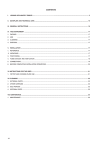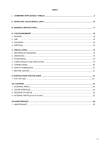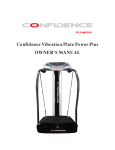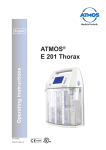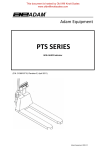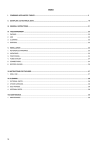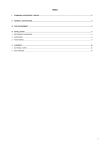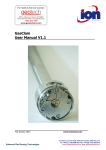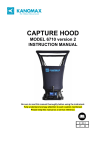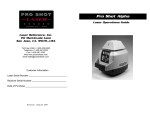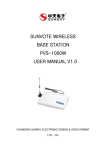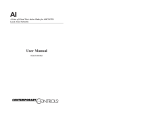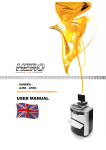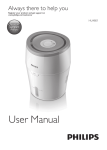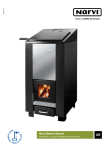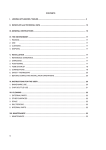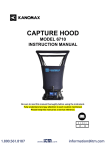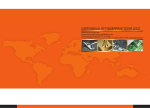Download User Manual - SharePoint
Transcript
CONTENTS I. INSTALLATION DIAGRAM / JOINING APPLIANCES / TABLES ............................................................................................. 2 II. DATAPLATE and TECHNICAL DATA ......................................................................................................................................... 21 III. GENERAL INSTRUCTIONS ....................................................................................................................................................... 22 IV. THE ENVIRONMENT .................................................................................................................................................................. 23 1. PACKING .................................................................................................................................................................................... 23 2. USE .................................................................................................................................................................................... 23 3. CLEANING ................................................................................................................................................................................... 24 4. DISPOSAL ................................................................................................................................................................................... 24 V. INSTALLATION ........................................................................................................................................................................... 23 1. REFERENCE STANDARDS ........................................................................................................................................................ 23 2. UNPACKING ................................................................................................................................................................................ 23 3. POSITIONING .............................................................................................................................................................................. 24 4. FUME EXHAUST AND VENTILATION ........................................................................................................................................ 24 5. CONNECTIONS ........................................................................................................................................................................... 24 6. BEFORE COMPLETING INSTALLATION OPERATIONS .......................................................................................................... 25 VI. USER INSTRUCTIONS ................................................................................................................................................................ 26 1. FRY TOP USE .............................................................................................................................................................................. 26 VII. CLEANING .................................................................................................................................................................................. 27 1. EXTERNAL PARTS ...................................................................................................................................................................... 27 2. OTHER SURFACES .................................................................................................................................................................... 27 3. IDLE PERIODS ............................................................................................................................................................................ 28 4. INTERNAL PARTS ....................................................................................................................................................................... 28 VIII. MAINTENANCE .......................................................................................................................................................................... 28 1. MAINTENANCE ........................................................................................................................................................................... 28 20 II. DATAPLATE and TECHNICAL DATA c TABLE A - Gas appliance technical data 169050 ARG12FLCE MODELS 169053 169055 169051 169052 169054 169056 169057 ARG24FLCE ARG36FLCE ARG48FLCE ARG12FRCE ARG24FRCE ARG36FRCE ARG48FRCE 169069 169070 169067 169068 169071 169072 ARG24FRCEP ARG36FRCEP ARG48FRCEP ARG24FLCEP ARG36FLCEP ARG48FLCEP 169073 169074 ARG24RRCEP ARG36RRCEP 305mm/12" 610mm/24" 915mm/36" 1220mm/48" 305mm/12" 610mm/24" 915mm/36" 1220mm/48" Gas connection Ø 3/4" 3/4" 3/4" 3/4" 3/4" 3/4" 3/4" 3/4" Burners Nr 1 2 3 4 1 2 3 4 Nominal heat output kW 6,5 13 19,5 26 6,5 13 19,5 26 169050 ARG12FLCE 305m m /12" 169051 ARG24FLCE 610m m /24" 169052 ARG36FLCE 915m m /36" 169053 ARG48FLCE 1220m m /48" 169054 ARG12FRCE 305m m /12" 169055 ARG24FRCE 610m m /24" 169056 ARG36FRCE 915m m /36" 169057 ARG48FRCE 1220m m /48" 3/4" 3/4" 3/4" 3/4" 3/4" 3/4" 3/4" 3/4" TECHNICAL DATA TABLE A - Gas appliance technical data MODELS TECHNICAL DATA BSP connection Burners Ø Nr 1 2 3 4 1 2 3 4 Btu/h 21800 43600 65400 87200 21800 43600 65400 87200 MJ/h 23 46 69 92 23 46 69 92 Nominal heat output 21 III. GENERAL INSTRUCTIONS • Read the instruction handbook carefully before using the appliance. • Keep the instruction handbook for future reference. • RISK OF FIRE - Keep the area around the appliance free and clear of combustibles. Do not keep flammable materials in the vicinity of the appliance. • Inadequate ventilation causes asphyxia. Do not obstruct the ventilation system in the place where this appliance is installed. Do not obstruct the vents or ducts of this or other appliances. sos • Place emergency telephone numbers in a visible position. • Keep the instructions to be followed in case of smell of gas in the room in a visible position. This information is available from the gas company. • Installation and maintenance must only be carried out by qualified personnel authorised by the manufacturer. For assistance, contact an authorised technical centre. Demand original replacements parts. • This appliance is designed for cooking food. It is intended for industrial use. Any use different from that indicated is improper. • This appliance is not intended for use by people (including children) with limited physical, sensory or mental abilities or without experience and knowledge of it, unless they are supervised or instructed in its use by a person responsible for their safety. • Personnel using the appliance must be trained. Do not leave the appliance unattended when in use. • Turn the appliance off in case of a fault or poor operation. • Do not use products (even if diluted) containing chlorine (sodium hypochlorite, hydrochloric or muriatic acid, etc.) to clean the appliance or the floor under it. Do not use metal tools to clean steel parts (wire brushes or Scotch Brite type scouring pads). • Do not allow oil or grease to come into contact with plastic parts. • Do not allow grime, fat, food or other residuals to form deposits on the appliance. • Do not clean the appliance with direct jets of water. L • given on the product indicates that it should not be regarded as domestic waste, but must be The symbol correctly disposed of in order to prevent any negative consequences for the environment and the health of people. For further information regarding the recycling of this product, contact the product agent or local dealer, the after-sales service or the local body responsible for waste disposal. • • • • • Warnings: Do not store or use gasoline or other flammable vapours, liquids or items in the vicinity of this or any other appliance. Do not spray aerosols in the vicinity of this appliance while it is in operation. Never check for leaks with an open flame The appliance is not suitable for a marine environment. Failure to observe the above can compromise the safety of the appliance. Failure to observe the above invalidates the warranty. 22 IV. THE ENVIRONMENT V. INSTALLATION 1. PACKING • The packing materials are environmentally friendly and can be stored without risk or burned in an appropriate waste incineration plant. Recyclable plastic components are marked with: PE Polyethylene: outer wrapping, instruction booklet bag, gas nozzle bag. • Polypropylene: roof packing panels, straps. Carefully read the installation and maintenance procedures given in this instruction manual before installing the appliance. • Installation, maintenance and conversion to another type of gas must only be carried out by qualified personnel authorised by the manufacturer. Failure to observe the correct installation, conversion and modification procedures can result in damage to the appliance, danger for people, and invalidates the Manufacturer’s warranty. PP Polystyrene foam: corner protectors. PS 2. USE Our appliances offer high performance and efficiency. To reduce electricity, water or gas consumption, do not use the appliance empty or in conditions that compromise optimum efficiency (e.g. with doors or lids open, etc.); the appliance must be used in a well-ventilated place, to avoid the creation of dangerous mixtures of unburnt gases in the room. When possible, preheat only before use. 3. CLEANING In order to reduce the emission of pollutants into the environment, clean the appliance (externally and when necessary internally) with products that are more than 90% biodegradable (for further information refer to section VII “CLEANING”). 4. DISPOSAL Do not disperse in the environment. Our appliances are manufactured using more than 90% (in weight) recyclable metals (stainless steel, iron, aluminium, galvanised sheet, copper, etc.). Make the appliance unusable by removing the power cable and any compartment or cavity closing devices (when present) in order to avoid the risk of someone becoming trapped inside. 1. REFERENCE STANDARDS • This appliance must comply with the applicable federal, state or local regulations. These installation procedures must be carried out by qualified personnel, otherwise the warranty will be invalidated. • AUSTRALIA: this appliance shall be installed only by authorised persons and in accordance with the manufacturer’s installation instructions, local gas fitting regulations,municipal building codes, electrical wiring regulations, local water supply regulations, AS5601-gas installation, health authorites and any other statutory regulations. 2. UNPACKING ATTENTION! Immediately check for any damage caused during transport. • The forwarder is responsible for the safety of the goods during transport and delivery. • Inspect the packing before and after unloading. • Make a complaint to the forwarder in case of visible or hidden damage, reporting any damage or shortages on the dispatch note upon delivery. • The driver must sign the dispatch note: The forwarder can reject the claim if the dispatch note is not signed (the forwarder can provide the necessary form). • Unpack, taking care not to damage the appliance. Wear protective gloves. • Carefully remove the protective film from metal surfaces and clean any traces of glue with a suitable solvent. • For hidden damage or shortages becoming apparent only after unpacking, request the forwarder for inspection of the goods within and not later than 15 days of delivery. • Keep all the documentation contained in the packing. 23 3. POSITIONING • • • • • • • Handle the appliance with care in order to avoid damage or danger to people. Use a pallet for handling and positioning. The installation diagram provided in this instruction manual gives the appliance dimensions and the position of connections. Check that they are available and ready for making all the necessary connections. The appliance can be installed separately or combined with other appliances of the same range. The appliances are not designed for built-in installation; ensure a distance of at least 4”/100mm from any combustible side walls and the rear wall, to allow connection and aeration of the burners; in case of noncombustible side walls, the appliance can be brought near (0"/0 mm). Suitably insulate surfaces that are at distances less than those recommended. Do not store or use flammable materials and liquids near the appliance. Check and if necessary level the appliance after positioning. Incorrect levelling can cause appliance malfunctioning. 5. CONNECTIONS • • • Any installation work or maintenance to the supply system must only be carried out by the utility company or an authorised installer. Refer to the appliance dataplate for the product code. See the installation diagram for the type and position of appliance connections. 5.1. GAS APPLIANCES IMPORTANT! This appliance is arranged and tested to operate on Natural gas 10mbar; to convert it to another type of gas, follow the instructions in par. 5.1.6. of this section. 5.1.1. BEFORE CONNECTING • • Make sure the appliance is arranged for the type of gas to be used. Otherwise, carefully follow the instructions given in the section: “Gas appliance conversion / adjustment”. Fit a rapid gas shut-off cock/valve ahead of each appliance. Install the cock/valve in an easily accessed place. 3.1. JOINING APPLIANCES (Fig. 1A- 1B-1C-1D-1E-1F) • • • • • • • • Remove the knobs “M” and control panels “C” of the appliances, removing the 4 fixing screws “V” (Fig. 1A). Remove the precut “PT” (FIG.1B) from each side to be joined. Bring the appliances together and level them by turning the feet until the tops match (FIG.1C). From inside the control panel of the appliances, join them at the front part, tightening one M5x40 hex head screw on the nut (supplied) (FIG.1D). Remove the screws “V” (FIG.1E). Position the plate “P” to match the holes and fix it using the screws supplied (FIG.1F). Refit the control panels and knobs. Use NSF silicone to seal the gaps between joined appliances and tops on refrigerated or compartment base. 4. FUME EXHAUST AND VENTILATION • Only install the appliance in a wellventilated place. • Do not obstruct the ventilation system in any way. • Do not obstruct the vent and discharge holes of this appliance or others present in the room. ATTENTION! Inadequate ventilation causes appliance malfunction and creates the risk of asphyxia and danger to people. For Australia, ventilation must be in accordance with australian building codes and kitchen exhaust hoods must comply with AS/NZS1668.1 and AS 1668.2 24 • • Clean the pipes to remove any dust, dirt or foreign matter which could block the supply. The gas supply line must ensure the gas flow necessary for full operation of all the appliances connected to the system. A supply line with insufficient flow will affect correct operation of the appliances connected to it. 5.1.2. CONNECTION • See the installation diagram for the position of the gas connection on the bottom of the appliance. • Remove the plastic protection cover (if present) from the appliance gas union before connecting. • After installation, use soapy water to check connections for leaks. • The gas connection is male 1/2” BSP 5.1.3. SUPPLY PRESSURE CHECK Make sure the appliance is suitable for the type of gas available, according to that specified on the dataplate (otherwise, follow the instructions in the par. “Conversion to another type of gas”). The supply pressure must be measured with the appliance operating, using a manometer (min. 0.1 mbar). • Remove the control panel. • Remove screw “N” from the pressure point and connect the manometer “O” (fig. 2A). • Compare the value read on the manometer with that given in table B (see handbook Appendix) • If the manometer gives a pressure outside the range of values in Table B, do not use the appliance. Consult the gas company. 5.1.4 GAS PRESSURE REGULATOR • A gas pressure regulator (supplied in a plastic bag with the appliance)must be installed in an easily accessed position ahead of the appliance. The pressure regulator should preferably be fitted horizontally, to ensure the right outlet pressure: • “1” connection side gas from mains. • “2” pressure regulator (3.3"x2.9"x2.7" / 85x75x71mm); • “3” connection side gas towards the appliance; ) indicates the gas flow The arrow on the regulator ( direction. 2 5.1.6.1 MAIN BURNER NOZZLE REPLACEMENT • Remove the control panel. • Unscrew nozzle “C” and replace it with one suitable for the type of gas (fig.3A) according to that given in Table B. • The nozzle diameter is given in hundredths of mm on the nozzle body. • Tighten down nozzle “C”. 5.1.6.2 PILOT BURNER NOZZLE REPLACEMENT • Remove the control panel. • Undo screw coupling “H” and replace nozzle “G” with one suitable for the type of gas (Table B, fig.3b). • The nozzle identification number is given on the nozzle body. • Retighten screw coupling “H”. 5.1.6.3 REPLACING THE ADJUSTMENT SPRING OF THE PRESSURE REGULATOR 3 1 AUSTRALIA: the gas pressure regulator supplied with the appliance must be fitted to the appliance inlet. Adjust the test point pressure with all hob burners operating at maximum setting as follow: - 1.0 KPa for Natural gas - 1.8 KPa for Propane gas 5.1.5. PRIMARY AIR CHECK When the primary air is correctly adjusted, the flame does not “float” with burner cold and there is no flareback with burner hot. • Undo screw “A” and position aerator “C” at distance “H” given in Table B; retighten screw “A” and seal with paint (fig. 3A). • Replace the spring of the pressure regulator with one suitable for the gas pressure type given in table B (see handbook Appendix) as follows: - Remove the seal cap, seal cap gasket, adjusting screw and the spring. - Insert the new spring and replace the adjusting screw. - Connect a pressure gauge to the appliance’s test point pressure (fig. 2A/2B). - Ignite the appliance’s burners so to have the maximum gas consumption. - Regulate the adjustment screw until the pressure gauge shows the working pressure value (section 5.1.4 Gas pressure regulator). - Replace the seal cap and gasket and screw tightly closed. - Remove the pressure gauge and close the test point pressure. - Prior to operation, test the gas pressure regulator for leaks. 5.1.6. CONVERSION TO ANOTHER TYPE OF GAS Table B “Technical data/gas nozzles” gives the types of nozzles (contained in a bag supplied with the appliance, together with the pressure regulator) to be used when replacing those fitted by the manufacturer; the number is stamped on the nozzle body. At the end of the procedure, carry out the following check-list: Check Ok • burner nozzle/s replacement • correct adjustment of primary air supply to burner/s • pilot nozzle/s replacement • minimum flame screw/s replacement • correct adjustment pilot/s if necessary • correct adjustment of supply pressure (see technical data/gas nozzles table) • apply sticker (supplied) with data of new gas type used 6. BEFORE COMPLETING INSTALLATION OPERATIONS THE Use soapy water to check all gas connections for leaks. DO NOT use a naked flame to check for gas leaks. Light all the burners individually and also together, to check correct operation of the gas valves, rings and lighting. For each burner, adjust the flame regulator to the lowest setting, individually and together; after completing the operations, the installer must instruct the user on the correct method of use. If the appliance does not work properly after carrying out all the checks, contact the local after-sales service centre. 25 1.1. GAS MODELS VI USER INSTRUCTIONS C 90 C 1. FRY TOP USE • • • • • • • • • The appliance is intended for industrial use by trained personnel. Do not use the appliance empty or in conditions that compromise its optimum efficiency. Also, if possible, preheat the appliance immediately before use. The fry-top is designed for direct cooking of food on the hot-plate (hamburgers, chops, eggs, sausages, fish, vegetables, etc.). Any other use is deemed improper. Every day before use, empty the oil collection container with the appliance cold (if necessary, empty it several times a day). Do not use the fry-top to warm pots or pans. Frytop 305mm/12”: it consists of a single cooking zone controlled by a thermostatic gas valve. The bulb for measuring the temperature is located in the middle of the plate; Frytop 610mm/24”: it consists of two cooking zones (left and right side) controlled by two thermostatic gas valves, one for each zone. The bulbs for measuring the temperature are located in the middle of each sector (from left to right respectively). Frytop 915mm/36”: it consists of three cooking zones (left, middle and right side) controlled by three thermostatic gas valves, one for each zone. The bulbs for measuring the temperature are located in the middle of each sector (left, middle and right side respectively). Frytop 1220mm/48”: it consists of four cooking zones (from left to right) controlled by four thermostatic gas valves, one for each zone. The bulbs for measuring the temperature are located in the middle of each sector (from left to right respectively). 260 120 240 150 180 210 A Switching on The thermostatic valve control knobs have the following positions: Knob A: OFF “Off” PILOT “Pilot on” ON “On” Knob B: required temperature adjustment. • • • • Press and turn knob “A” to “pilot”. Light the pilot using a long-neck lighter through hole “C” on the control panel; keep it in this position for about 15/ 20 seconds to allow the gas to reach the pilot burner and the thermocouple to heat. Lighting of the pilot burner can be seen through hole “C” in the control panel. Turn knob “A” to “on” to light the burner. Then select the required temperature with knob “B”. Switching off • Turn knob “A” to “off”. At end of service: • close the gas shut-off cock. 26 B 1.2. GAS MODELS WITH PILOT IGNITION C 90 C 260 120 240 150 180 210 B VII CLEANING ATTENTION! Disconnect the appliance from the power supply before carrying out any cleaning. Do not use ice or water to quickly cool the hot-plate: do not use ice or water for cleaning when the plate is hot since, this will permanently deform it and compromise appliance operation. Improper cleaning automatically invalidates the warranty. 1. EXTERNAL PARTS A SWITCHING ON The thermostatic valve control knobs have the following positions: Knob A: V C A “Off” “Pilot ignition” “On” Knob B: required temperature adjustment. • • • Press knob “A” lightly and at the same time turn it anticlockwise a few degrees to release it. Press down fully and turn it to position C; a click will indicate sparking. Keeping knob “A” pressed, turn it to position A and hold it there for about 15/20 seconds to allow the gas to reach the pilot burner and the thermocouple to heat. Lighting of the pilot burner can be seen through hole “C” in the control panel. ATTENTION: Always keep the pilots of all the cooking zones lit, even in case of partial use of the Frytop. • • Use knob “B” to select the required temperature. In case of emergency, the pilot burner can be lit manually by bringing a flame to it after removing the grease tray and keeping knob “A” pressed in the “pilot ignition” position. SATIN-FINISH STEEL SURFACES (daily) • Clean all steel surfaces: dirt is easily removed when it has just formed. • Remove grime, fat and other cooking residuals from steel surfaces when cool using soapy water, with or without detergent, and a cloth or sponge. Dry the surfaces thoroughly after cleaning. • In case of encrusted grime, fat or food residuals, go over with a cloth or sponge, wiping in the direction of the satin finish and rinsing often: rubbing in a circular motion combined with the particles of dirt on the cloth/sponge could spoil the steel’s satin finish. • Metal objects can spoil or damage the steel: damaged surfaces become dirty more easily and are more subject to corrosion. • Restore the satin finish if necessary. SURFACES BLACKENED BY HEAT (when necessary) Exposure to high temperatures can cause the formation of dark marks. These do not constitute damage and can be removed by following the instructions given in the previous section. 2. OTHER SURFACES SURFACES IN SOFT IRON OR CAST IRON (daily) Remove grime using a damp cloth or, in case of encrustations, the accessories (optional or supplied) specified in the list. After cleaning, switch the appliance on to dry the surface quickly, then lightly lubricate the surface with cooking oil. SWITCHING OFF • To turn off the main burner, turn knob “A” to position C. • Turn knob “A” to position V to turn off the pilot burner. At end of service: • turn knob “A” to position V • close the gas shutoff cock. 1.1.3. INTERLOCK The valve has a thermal device (interlock) that prevents relighting for about 40 seconds (sufficient time for the safety thermocouple to cool) if the pilot burner goes out. 27 Attention: Do not use the edge scraper (see figure) as it will scratch the plate, permanently compromising its functionality and cleanability. Replace the blade whenever it is not perfectly sharp. COLLECTION TRAYS AND TANKS (even several times a day) Remove any grease, oil, food residuals, etc., from tanks, trays and containers in general used for collection. Always clean the containers at the end of the day. While using the appliance, empty them when they are nearly full. VIII MAINTENANCE 1. MAINTENANCE All the components requiring maintenance are accessible from the front of the appliance, after removing the control panel. 1.1 BRIEF TROUBLESHOOTING GUIDE Even with normal use, malfunctions can occur. 3. IDLE PERIODS If the appliance is not going to be used for some time, take the following precautions: • Close cocks or main switches ahead of the appliance. • Go over all stainless steel surfaces vigorously with a cloth moistened with paraffin oil in order to create a protective film. • Air the premises periodically. • Have the appliance checked before using it again. • To prevent too rapid evaporation of accumulated moisture with consequent breakage of elements, switch electric appliances on at minimum heat for at least 45 minutes before reuse. 4. INTERNAL PARTS (every 6 months) IMPORTANT! Operations to be carried out only by specialised technicians. • Check the condition of internal parts. • Remove any deposits of dirt inside the appliance. • Check and clean the discharge system. • Remove the 4 screws “V” and back “S” to access the inner rear part of the appliance. V S NOTE: In particular conditions (e.g. intensive appliance use, salty environment, etc.) the above cleaning should be more frequent. 28 The pilot burner does not light Possible causes: • Insufficient pressure in gas pipes. • Blocked nozzle. • Faulty gas valve. The pilot burner goes out when the igniter knob is released Possible causes: • The pilot burner is not heating the thermocouple sufficiently. • Faulty thermocouple. • The gas valve knob is not being pressed enough. • Lack of gas pressure at the valve. • Faulty gas valve. The pilot burner is still lit but the main burner does not light Possible causes: • Loss of pressure in gas pipe. • Blocked nozzle or faulty gas valve. • Burner with gas outlet holes clogged. The fry-top temperature cannot be adjusted. Possible causes: • Thermostat bulb faulty or not properly fitted. • Faulty gas valve. INSTRUCTIONS FOR REPLACING COMPONENTS (to be carried out only by an authorised installer). VALVE • Remove the knobs and control panel. • Unscrew the pilot and thermocouple pipe. • Unscrew the gas inlet and outlet connections. • For installation carry out the same procedure in reverse order. THERMOCOUPLE, PILOT BURNER ASSEMBLY • Remove the knobs and control panel. • Unscrew the pilot and thermocouple pipe. • Replace the component. FRYTOP MAIN BURNER • Remove the knobs and control panel. • Remove the clamp fixing the burner to the gas pipe and nozzle holder. • Unscrew the pilot and thermocouple pipe. • Unscrew and remove the main burner closing sheet. • Remove the burner and replace it. For installation carry out the same procedure in reverse order. 1.2 MAINTENANCE SCHEDULE • It is advisable to have the appliance inspected by an authorised person at least every 12 months. For this purpose, it is advisable to stipulate a servicing contract. AUSTRALIA For service and spare parts, please contact: Electrolux - Tom Stoddart Pty Ltd 29










